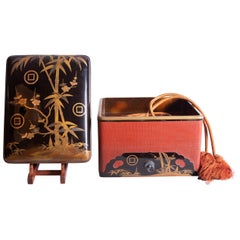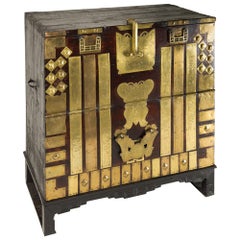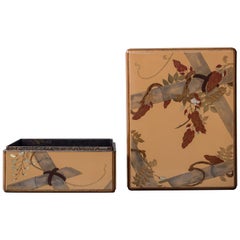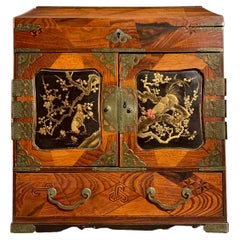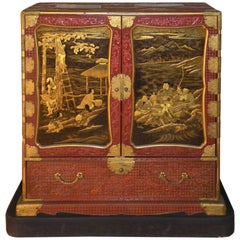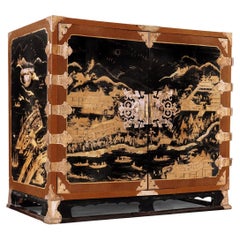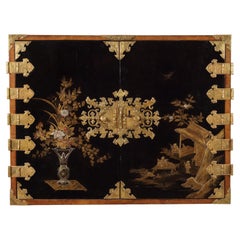Items Similar to Japanese 19th Century Miniature Lacquer Chest with Waterfall
Want more images or videos?
Request additional images or videos from the seller
1 of 21
Japanese 19th Century Miniature Lacquer Chest with Waterfall
$38,000
£28,197.47
€32,846.19
CA$52,896.28
A$58,904.77
CHF 30,656.68
MX$726,288.76
NOK 390,436.26
SEK 366,972.24
DKK 245,073.36
Shipping
Retrieving quote...The 1stDibs Promise:
Authenticity Guarantee,
Money-Back Guarantee,
24-Hour Cancellation
About the Item
Japanese 19th century miniature lacquer chest with waterfall. Late Edo to early Meiji period lacquer chest (mid to late 19th century) with two characters on the front reading Nuno and Biki. Nunobiki Waterfall, one of the few holy waterfalls in Japan, is located between Kobe and Osaka, and was often mentioned in poems throughout history. This chest displays expert examples of various lacquer techniques rendering a continuous scene of Nunobiki 360 degrees around the entire box. A beautiful use of gold including large pieces of gold heart shaped leaves falling, and a gold speckled ground suggesting mist from the falls. Bronze hardware is incised with motifs of flowing water and fish. An incredible example of lacquer mastery. Comes in a lacquer storage box which is lined with washi paper.
Famous poem was written by Kujo Kanezane, a 12th century aristocrat: "Climbing the sandy mountain where the god that rules / water resides in Ashino ya (the place where there are lots of reeds) / oh, I stumble in to Nunobiki falls."
- Dimensions:Height: 15 in (38.1 cm)Width: 14.5 in (36.83 cm)Depth: 9.25 in (23.5 cm)
- Materials and Techniques:
- Place of Origin:
- Period:
- Date of Manufacture:Mid-Late 19th Century
- Condition:Most items that are 100 years old have been cleaned or polished in their lifetime. More involved restorations are mentioned in the above description. For a detailed condition report and a video of this item please contact us directly. -Naga Antiques.
- Seller Location:Hudson, NY
- Reference Number:Seller: A51901stDibs: LU855122045872
About the Seller
5.0
Recognized Seller
These prestigious sellers are industry leaders and represent the highest echelon for item quality and design.
Established in 1971
1stDibs seller since 2008
166 sales on 1stDibs
Typical response time: 7 hours
Associations
The Art and Antique Dealers League of AmericaAntiques Associations Members
- ShippingRetrieving quote...Shipping from: Craryville, NY
- Return Policy
Authenticity Guarantee
In the unlikely event there’s an issue with an item’s authenticity, contact us within 1 year for a full refund. DetailsMoney-Back Guarantee
If your item is not as described, is damaged in transit, or does not arrive, contact us within 7 days for a full refund. Details24-Hour Cancellation
You have a 24-hour grace period in which to reconsider your purchase, with no questions asked.Vetted Professional Sellers
Our world-class sellers must adhere to strict standards for service and quality, maintaining the integrity of our listings.Price-Match Guarantee
If you find that a seller listed the same item for a lower price elsewhere, we’ll match it.Trusted Global Delivery
Our best-in-class carrier network provides specialized shipping options worldwide, including custom delivery.More From This Seller
View AllFine Lacquer Kogo 'Incense Box'
Located in Hudson, NY
Exquisitely detailed incense storage box in gold lacquer with silver and gold overlays of a folded screen with heron and willow design. Flowers and...
Category
Antique Late 19th Century Japanese Meiji Lacquer
Materials
Lacquer
Japanese Lacquer Box with Bamboo, Plum, and Family Crest
Located in Hudson, NY
Made with heavy gold flakes and lacquered fabric on wood, with cutout heart designs. Has an interior tray, and comes with silk tasseled ties. (Does not come with presentation stand).
Category
Antique 19th Century Japanese Lacquer
Materials
Lacquer
Antique Korean Blanket Chest
Located in Hudson, NY
Antique Korean Blanket chest, elaborately decorated with ornate brass mounts in various geometric forms, some of which have incised landsc...
Category
Early 20th Century Korean Furniture
Materials
Brass
Japanese Lacquer Letter Box with Flowers and Butterfly
Located in Hudson, NY
With silver rim, and interior decoration of falling petals and gold dust. Comes with original storage box.
Category
Early 20th Century Japanese Meiji Lacquer
Materials
Lacquer
Japanese Lacquer Koro 'Incense Burner'
Located in Hudson, NY
Removable bronze top, with gold drip pattern at top. Cresting ocean waves on bottom with raised silver sea spray.
Category
Antique Early 19th Century Japanese Edo Lacquer
Materials
Silver, Bronze
Japanese Nashiji Lacquer Tray with Crane and Wave Design
Located in Hudson, NY
Japanese Nashiji lacquer tray with crane and wave design, this exquisite tray is a masterful example of multiple lacquer techniques using gold (including maki-e and takamaki-e). This...
Category
Antique Late 19th Century Japanese Meiji Lacquer
Materials
Gold
You May Also Like
Japanese Marquetry and Lacquer Jewelry Chest, Meiji Period, circa 1900, Japan
Located in Austin, TX
A very attractive Japanese wood table top jewelry or collector's chest with marquetry and lacquer decoration, Meiji period, circa 1900, Japan. Previously in the collection of Asbjorn Lunde (1927 - 2017).
The chest is crafted in the form of a Chinese seal...
Category
Antique Early 1900s Japanese Meiji Lacquer
Materials
Wood, Softwood, Lacquer
Japanese Lacquer and Cinnabar "Samurai" Cabinet, Inaba Family, Edo Period
Located in Troy, NY
Exceptionally large and rare lacquer cabinet. According to the heraldry, visible on the headgear in one of the panels, it was made for the Inaba family, a high ranking Daimyo family,...
Category
Antique Late 19th Century Japanese Edo Lacquer
Materials
Wood
17th Century Japanese Export Lacquer Cabinet with Depiction the Dutch Tradepost
Located in Amsterdam, NL
A highly important Japanese export lacquer cabinet with depiction of the Dutch East India Company tradepost Deshima and the annual Dutch delegation on its way to the Shogun in Edo
Edo period, circa 1660-1680
H. 88 x W. 100.5 x D. 54 cm
This cabinet includes a later European japanned stand, but also a modern powder-coated steel frame.
The latter can be designed and added to your specific needs.
The sides and front of the rectangular two-door cabinet are embellished in gold and silver hiramaki-e and takamaki-e on a black roiro lacquer ground with a continuous design. The two doors depict a long procession of numerous figures travelling on foot and horseback along buildings and a pagoda into a mountainous landscape. This is the annual court journey, Hofreis, of the Dutch from Nagasaki to the Shogun’s court in Edo. Three horseback riders are dressed as Dutch merchants and a fourth figure, probably het Opperhoofd, is seen inside a palanquin, norimon. Just about to cross the bridge, two men are carrying a cabinet like the present one.
Many Japanese figures on either side of the procession are engaged in various activities; some play musical instruments on board of small boats, others are fishing; figures inside buildings are depicted playing go, and farmers are tending to their rice paddocks. The upper part of the right door shows a large mansion, probably the local daimyo’s castle, with men kneeling before a man in the central courtyard.
The court journey fits in with the foreign policy of the shogunate which accorded a role to the VOC alongside China, Korea, and the Ryukyu Islands who also had to pay tribute. However, the VOC employees were traders, having low status in Japan’s social hierarchy, and they were received with less deference than were the state embassies from Korea and the Ryukyu Islands. Nevertheless, the contacts with the Dutch were a welcome source of information to the Shogun about Europe and European science and technology.
The left side of the cabinet depicts, in mirror image, a rare view of the artificial fan-shaped Deshima Island, the trading post for the Dutch in Japan. The island, where the Dutch flag flies, is surrounded by small Japanese boats and an anchored three-masted fluyt (cargo ship), flying Dutch flags, with on the stern the VOC monogram. On the bottom right a busy street of Nagasaki is shown, bordered by shops and leading up to the stone bridge. On the island the trees are beautifully painted, two cows can be seen, and the flagpole, all in very fine detail. Dutchmen and enslaved Malay are visible outside the buildings and two Japanese figures, probably guards, sit in a small hut in the centre.
A maximum of fifteen to twenty Dutchmen lived on the island at any time and soldiers or women were not allowed. Restrictions on Deshima were tight, and the merchants were only allowed to leave the island by special permission. The Opperhoofd had to be replaced every year, and each new Opperhoofd had to make a court journey to pay tribute, present gifts, and to obtain permission to Margaret Barclay eep on trading. In the distance, many birds fly above the hills and a four-story pagoda can be seen. The right side of the cabinet is painted with other horse riders and their retinue journeying through mountains.
The pair of doors to the front open to reveal ten rectangular drawers. The drawers are decorated with scenes of birds in flight and landscapes with trees and plants. The reverse of the left door with two thatched buildings, one with a ladder, underneath a camelia tree with large blooms; the right door with a three-story pagoda nestled among trees and both doors with a flying phoenix, ho-oo bird. The cabinet, with elaborately engraved gilt copper mounts, hinges, lock plates and brass handles, is raised on an 18th-century English japanned wood stand.
A pair of large cabinets...
Category
Antique 17th Century Japanese Edo Lacquer
Materials
Copper, Gold
$1,504,557
Free Shipping
Extremely Fine and Rare 17th-Century Japanese Export Lacquer and Inlaid Cabinet
Located in Amsterdam, NL
An extremely fine and important Japanese lacquer cabinet with gilt-copper mounts for the European market
Edo period, late 17th century
The pictorial style decorated rectangular...
Category
Antique Late 17th Century Japanese Lacquer
Materials
Brass
Price Upon Request
Free Shipping
Important Early Edo Period 17th Century Miniature Japanese Lacquer Cabinet
Located in Oxfordshire, United Kingdom
A Rare and Important 17th Century Miniature Japanese Lacquer Cabinet, 19 cm H, 17cm W, 16.5cm D.
The exquisitely decorated cabinet depicts fine floral raised scenes to each side. l...
Category
Antique 17th Century Decorative Boxes
Materials
Lacquer
Rare Charming 17th Century Japanese Lacquer Cabinet with Gilt-Bronze Mounts
Located in Amsterdam, NL
A fine Japanese pictoral style lacquer cabinet with gilt-metal mounts
Kyoto, Edo period, 1670-1690
Decorated in Japanese relief lacquer work, black lacquer ground decorated...
Category
Antique Late 17th Century Japanese Furniture
Materials
Bronze
$45,136 Sale Price
25% Off
Free Shipping
More Ways To Browse
Washi Paper Japanese
Antique Waterfall
Lacquered Large Boxes
Large Lacquer Box
Japanese Hardware
Chest With Fish
Antique Japanese Fish
19th Century Japanese Chest
Large Bronze Fish
Lacquer Chest Japan
Antique Heart Shaped Box
Antique Japanese Silver Box
Silver Antique Japanese Boxes Silver Boxes
Antique Holy Water
Japanese Lacquer Chest Antique
Waterfall Lacquer
12th Century Bronze
Heart Shaped Box




